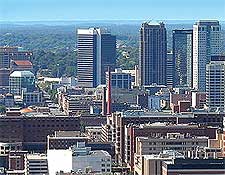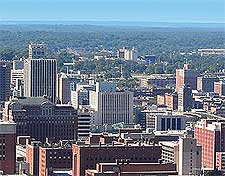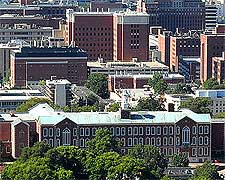Birmingham History Facts and Timeline
(Birmingham, Alabama - AL, USA)

First founded in 1871 through the merger of three neighboring farming towns, the city of Birmingham, Alabama, has a checkered history. Its earliest days saw the city grow into one of the most important industrial hubs in the Deep South, focusing on iron, steel and the railways. It also provided much needed employment for the African-American population who resided in the region.
The lack of union support meant that many of these low-paid workers were shabbily treated, while a number of racially-motivated attacks throughout the 1950s and '60s left a black mark on the history of Birmingham.
The Foundation of the City
Unsurprisingly, the first settlers in the farming towns preceding Birmingham were from
England. In 1871, the Elyton Land Company borrowed the name 'Birmingham' from its counterpart in the British Midlands, since it was one of the most industrialized cities in England at that time.
The founders of the Elyton Land Company had great plans for the city, hoping to take advantage of the huge deposits of iron ore, limestone and even coal in the vicinity, since all of these materials are essential in the production of steel. The best place to learn about Birmingham's steel history is at the Iron and Steel Museum of Alabama, located at the Tannehill Ironworks Historical State Park in the nearby community of McCalla, roughly 30 minutes to the southwest.

Rapid Growth and Decline
From 1870 to 1880, the city grew so quickly that it was nicknamed the 'Magic City'. It was so called because this industrialized center seemed to appear overnight, 'like magic'. The 1873 cholera epidemic was a setback, but the turn of the century saw the earliest skyscrapers and tramlines appear on the city's streets.
This rapid growth came to an abrupt halt at the time of the Great Depression, a period when Birmingham was affected more than most cities due to its reliance on heavy industry. However, the building boom after WWII brought a much needed respite from the misery that began well before the war. It allowed many locals to return to work, while manufacturers took the opportunity to diversify away from the traditional field of steel production.

The Civil Rights Movement
The most notable period in the history of Birmingham, with regard to worldwide attention, came during the 1950s and '60s. Race relations were at rock bottom and bomb attacks were a regular occurrence. In 1963, the 16th Street Baptist Church was bombed, leading to the deaths of four girls. It was a meeting place for black groups campaigning against racism in Birmingham and across the Deep South, with the location having attracted prominent speakers including Martin Luther King.
The church is now a National Historic Landmark, receiving more than 200,000 visitors every year. Visitors can learn about the bombing and the Civil Rights movement through a picture exhibition in the church's basement. The park opposite the church, the Kelly Ingram Park, was the site of a number of the most significant demonstrations. Guided tours are available, while the adjacent Birmingham Civil Rights Institute has its own onsite museum.
Despite violent attacks such as the one at the 16th Street Baptist Church, the Civil Rights movement was eventually successful, succeeding in the desegregation of all public areas in Birmingham, which ultimately contributed to the establishment of the 1964 Civil Rights Act.
Birmingham Today
Since the gradual decline of heavy industry, Birmingham has proved to be most versatile. The 1970s saw the city diversify into fields such as medical research, banking and car manufacture.
The 21st century has seen the gentrification of some of the neglected city-center areas, with a boom in condominium sales and restaurant openings in these 24-hour districts.
 First founded in 1871 through the merger of three neighboring farming towns, the city of Birmingham, Alabama, has a checkered history. Its earliest days saw the city grow into one of the most important industrial hubs in the Deep South, focusing on iron, steel and the railways. It also provided much needed employment for the African-American population who resided in the region.
First founded in 1871 through the merger of three neighboring farming towns, the city of Birmingham, Alabama, has a checkered history. Its earliest days saw the city grow into one of the most important industrial hubs in the Deep South, focusing on iron, steel and the railways. It also provided much needed employment for the African-American population who resided in the region.
